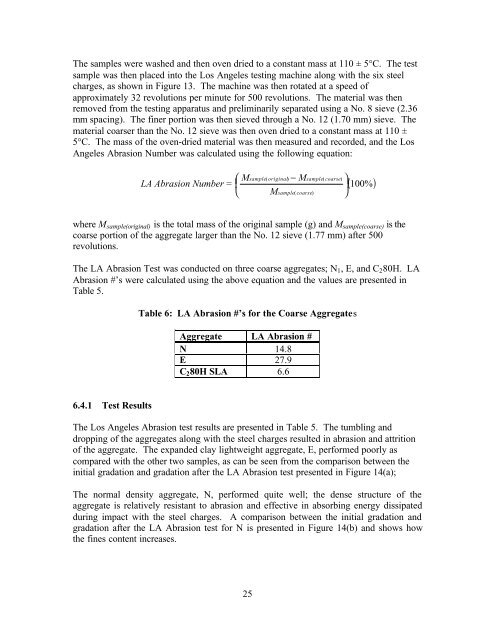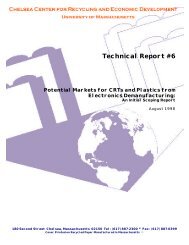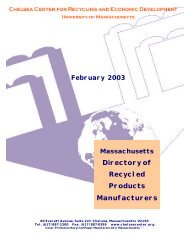fly ash/plastic synthetic aggregate for construction material
fly ash/plastic synthetic aggregate for construction material
fly ash/plastic synthetic aggregate for construction material
Create successful ePaper yourself
Turn your PDF publications into a flip-book with our unique Google optimized e-Paper software.
The samples were w<strong>ash</strong>ed and then oven dried to a constant mass at 110 ± 5°C. The test<br />
sample was then placed into the Los Angeles testing machine along with the six steel<br />
charges, as shown in Figure 13. The machine was then rotated at a speed of<br />
approximately 32 revolutions per minute <strong>for</strong> 500 revolutions. The <strong>material</strong> was then<br />
removed from the testing apparatus and preliminarily separated using a No. 8 sieve (2.36<br />
mm spacing). The finer portion was then sieved through a No. 12 (1.70 mm) sieve. The<br />
<strong>material</strong> coarser than the No. 12 sieve was then oven dried to a constant mass at 110 ±<br />
5°C. The mass of the oven-dried <strong>material</strong> was then measured and recorded, and the Los<br />
Angeles Abrasion Number was calculated using the following equation:<br />
⎛ M<br />
sample(<br />
original)<br />
sample(<br />
coarse)<br />
LA Abrasion Number = ⎜<br />
⎟( 100% )<br />
⎝<br />
M<br />
− M<br />
sample(<br />
coarse)<br />
⎞<br />
⎠<br />
where M sample(original) is the total mass of the original sample (g) and M sample(coarse) is the<br />
coarse portion of the <strong>aggregate</strong> larger than the No. 12 sieve (1.77 mm) after 500<br />
revolutions.<br />
The LA Abrasion Test was conducted on three coarse <strong>aggregate</strong>s; N 1 , E, and C 2 80H. LA<br />
Abrasion #’s were calculated using the above equation and the values are presented in<br />
Table 5.<br />
Table 6: LA Abrasion #’s <strong>for</strong> the Coarse Aggregates<br />
Aggregate LA Abrasion #<br />
N 14.8<br />
E 27.9<br />
C 2 80H SLA 6.6<br />
6.4.1 Test Results<br />
The Los Angeles Abrasion test results are presented in Table 5. The tumbling and<br />
dropping of the <strong>aggregate</strong>s along with the steel charges resulted in abrasion and attrition<br />
of the <strong>aggregate</strong>. The expanded clay lightweight <strong>aggregate</strong>, E, per<strong>for</strong>med poorly as<br />
compared with the other two samples, as can be seen from the comparison between the<br />
initial gradation and gradation after the LA Abrasion test presented in Figure 14(a);<br />
The normal density <strong>aggregate</strong>, N, per<strong>for</strong>med quite well; the dense structure of the<br />
<strong>aggregate</strong> is relatively resistant to abrasion and effective in absorbing energy dissipated<br />
during impact with the steel charges. A comparison between the initial gradation and<br />
gradation after the LA Abrasion test <strong>for</strong> N is presented in Figure 14(b) and shows how<br />
the fines content increases.<br />
25




